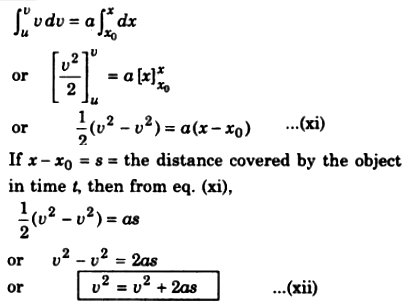Calculus method :
(i) Velocity-time relation : These equations can also be derived from calculus method. From the definition of acceleration;
a = \(\frac{d v}{d t}\) or dv = a dt
Integrating it with in the condition of motion (i.e.) when time changes from 0 to t, velocity changes from u to v, we get

This is the first equation of motion.
(ii) Distance time relation: The instantaneous velocity of an object in uniformly accelerated motion is given by
v = \(\frac{d x}{d t}\) or dx = v dt
v = u + at
∴ dx = (u + at) dt ………….. (vii)
Let the displacement of the object from the origin of position-axis is x0 at t = 0 and x at t = t, integrating both the sides of the equation (vii) within proper limits, we have,

If x - x0 = S = distance covered by the object in time t, then from eq. (viii)
s = ut + 1/2 at2 …………… (ix)
This is the second equation of uniform accelerated motion.
(iii) Velocity-displacement relation
The instantaneous acceleration is given by

Let u and v be the velocity of the object at positions given by displacements x0 and x.
Integrating the above equation (x) with the condition of motion, we get

This is the third equation of uniform acceleration motion.